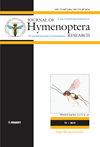Hygienic behavior and antimicrobial peptide expression of the leaf-cutting ant Atta cephalotes (Hymenoptera, Formicidae) to Metharhizium anisopliae
IF 1.5
3区 农林科学
Q2 ENTOMOLOGY
引用次数: 1
Abstract
Leaf-cutting ants depend on mutualisticfungi to survive. An infection that massively affects the workers compromising the proper maintenance of the fungus, or that can attack the fungus garden, can be fatal to the colony. Thus, leaf-cutting ants have evolved a complex defense system composed of both innate individual immunity and collective immunity to protect the colony against potential threats. To characterize the collective and individual immunity of Atta cephalotes workers to Metarizhium anisopliae we assessed the hygienic behavior and the expression of antimicrobial peptides of A. cephalotes workers triggered by Metarizhium anisopliae spores. As a control challenge, workers were treated with water. Regardless of whether the challenge was with water or spore suspension, A. cephalotes workers displayed an immediate response characterized by an increase in time spent both self-grooming and collective grooming along with a reduction in time spent fungus-grooming. The individual immunity triggered the expression of abaecin as early as 24 hours post-infection, exclusively in workers challenged with M. anisopliae. In contrast, the level of expression of defensin remained constant. These results suggest that upon being challenged with a suspension of M. anisopliae spores, A. cephalotes workers deploy both collective and individual immunity to produce a response against the invader. However, when the spores of M. anisopliae are applied as liquid suspension collective immunity deploys a generic strategy, while individual immunity shows a specific response against this entomopathogen.切叶蚁(膜翅目,蚁科)对绿僵菌Hygienic行为及抗菌肽的表达
切叶蚁依靠共生真菌生存。严重影响工人对真菌的正确维护,或可能攻击真菌园的感染,可能对菌落致命。因此,切叶蚁进化出了一个复杂的防御系统,由先天的个体免疫和集体免疫组成,以保护群体免受潜在威胁。为了表征阿塔头足类动物工作人员对绿脓杆菌的集体和个体免疫力,我们评估了绿脓杆菌孢子引发的头足类生物工作人员的卫生行为和抗菌肽的表达。作为一项控制挑战,工人们接受了水处理。无论挑战是用水还是孢子悬浮液,A.头足类动物的工作人员都表现出了即时反应,其特征是自我梳理和集体梳理的时间增加,真菌梳理的时间减少。个体免疫早在感染后24小时就触发了abaecin的表达,仅在感染M.anisopliae的工人中。相反,防御素的表达水平保持不变。这些结果表明,在受到M.anisopliae孢子悬浮液的攻击后,a.头足类动物的工作人员会部署集体和个体免疫力,以产生对抗入侵者的反应。然而,当M.anisopliae的孢子作为液体悬浮液应用时,集体免疫部署了一种通用策略,而个体免疫显示出对这种昆虫病原体的特异性反应。
本文章由计算机程序翻译,如有差异,请以英文原文为准。
求助全文
约1分钟内获得全文
求助全文
来源期刊
CiteScore
2.60
自引率
15.40%
发文量
68
审稿时长
>12 weeks
期刊介绍:
The Journal of Hymenoptera Research is a peer-reviewed, open-access, rapid online journal launched to accelerate research on all aspects of Hymenoptera, including biology, behavior, ecology, systematics, taxonomy, genetics, and morphology.
All published papers can be freely copied, downloaded, printed and distributed at no charge for the reader. Authors are thus encouraged to post the pdf files of published papers on their homepages or elsewhere to expedite distribution. There is no charge for color.

 求助内容:
求助内容: 应助结果提醒方式:
应助结果提醒方式:


